Alienware M18 vs Asus ROG Strix Scar 18: which behemoth should you choose?
Two massive 18-inch gaming laptops go under the microscope
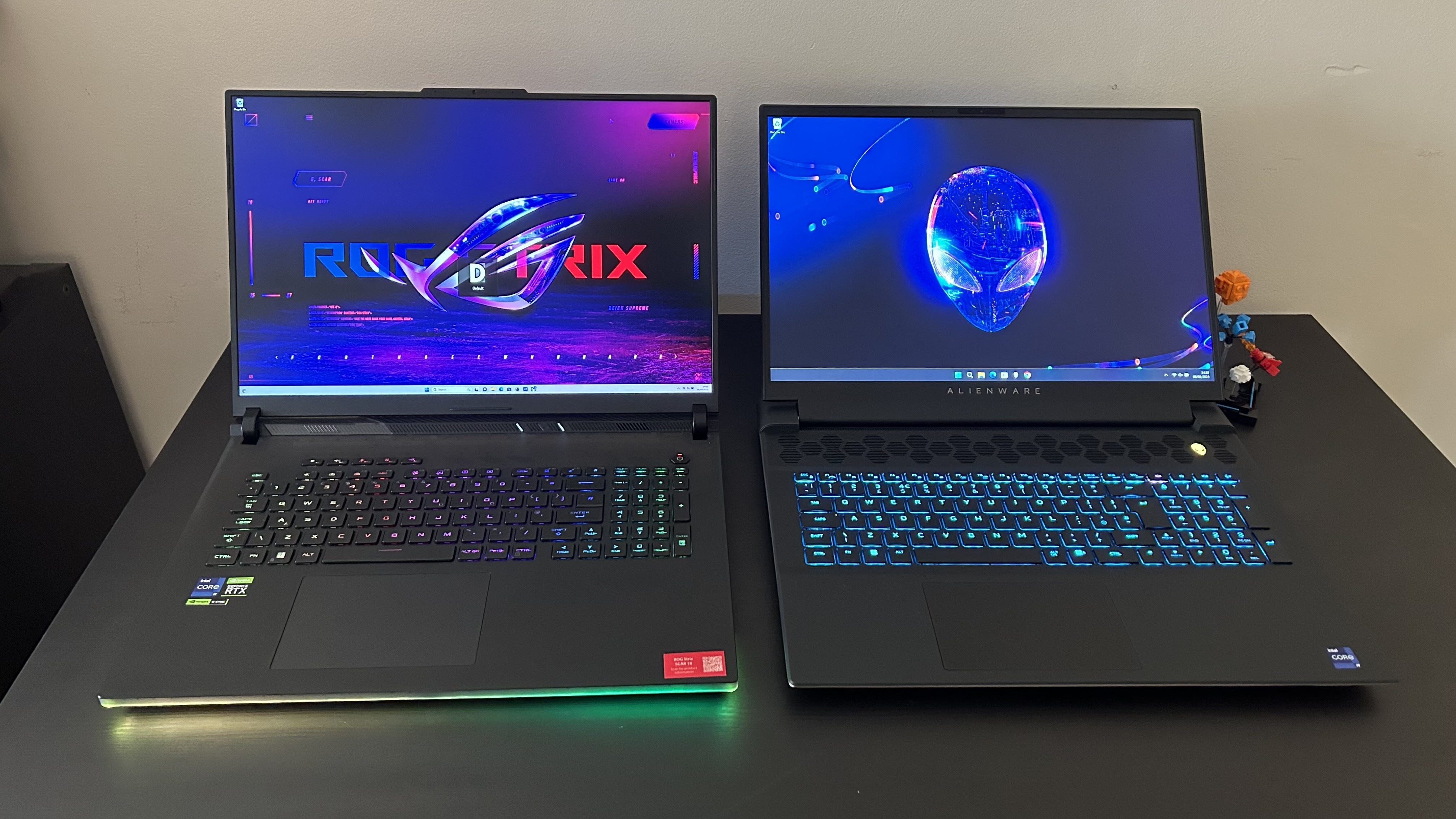
1. Pricing and Configurations
2. Design
3. Portability
4. Display
5. Keyboard
6. Performance
7. Extra features
8. Verdict
18-inch gaming laptops have firmly settled onto the shelves now. These powerful rigs are capable of running top shelf graphics cards and incredibly speedy processors in chassis' designed to replace your traditional desktop gaming PC. They make up some of the best gaming laptops on the market from a pure performance perspective right now, but there are two front-runners from the class of 2023.
The Alienware M18 and Asus ROG Strix Scar 18 both offer extreme levels of power but they also make different sacrifices in their specs and build as well. I've had my hands on both over the last couple of months, working out exactly which model those after a luxury big-screen experience should be buying. Both gaming laptops have earned a spot on our top list, with Asus's entry being the most powerful laptop I've ever tested, and the M18 being the best all-round 18-incher for most players - due to its range of configuration options.
That's not to say the decision is going to be clear-cut, though. There are just as many drawbacks to the M18 as there are extra features in the Scar 18. That's why I sat down with both laptops at the same time, during a particularly fortuitous crossover in review loans, to work out exactly who should be investing in which. One sits at the top of the best Alienware laptops and the other at the top of the best Asus gaming laptops around. If you find yourself coming back to the Alienware M18 vs Asus ROG Strix Scar 18 debate regularly, you'll find everything you need to know right here.
TL;DR
Alienware M18
- Cheaper
- More configurations available
- More sophisticated design
- Far less portable
- QHD+ display only runs at 165Hz
- Low brightness, lower quality screen
- Larger keys, smooth switches
- Slightly worse performance
- 1080p webcam
- Less powerful speakers
- Rear oriented ports
Asus ROG Strix Scar 18
- More expensive
- Fewer configurations available
- Boxy, RGB-filled design
- More portable with lower weight
- QHD+ display runs at 240Hz
- High brightness, super vivid screen
- Smaller keys, more tactile switches
- Slightly better performance
- 720p webcam
- More powerful speakers
- Ports placed on the side
| Row 0 - Cell 0 | Alienware M18 | Asus ROG Strix Scar 18 |
| Pricing and Configurations | ★★★★★ | ★★★☆☆ |
| Design | ★★★☆☆ | ★★☆☆☆ |
| Portability | ★☆☆☆☆ | ★★★☆☆ |
| Display | ★★★☆☆ | ★★★★★ |
| Keyboard | ★★★★☆ | ★★★☆☆ |
| Performance | ★★★★☆ | ★★★★★ |
| Extra features | ★★★★☆ | ★★★★☆ |
Pricing and Configurations
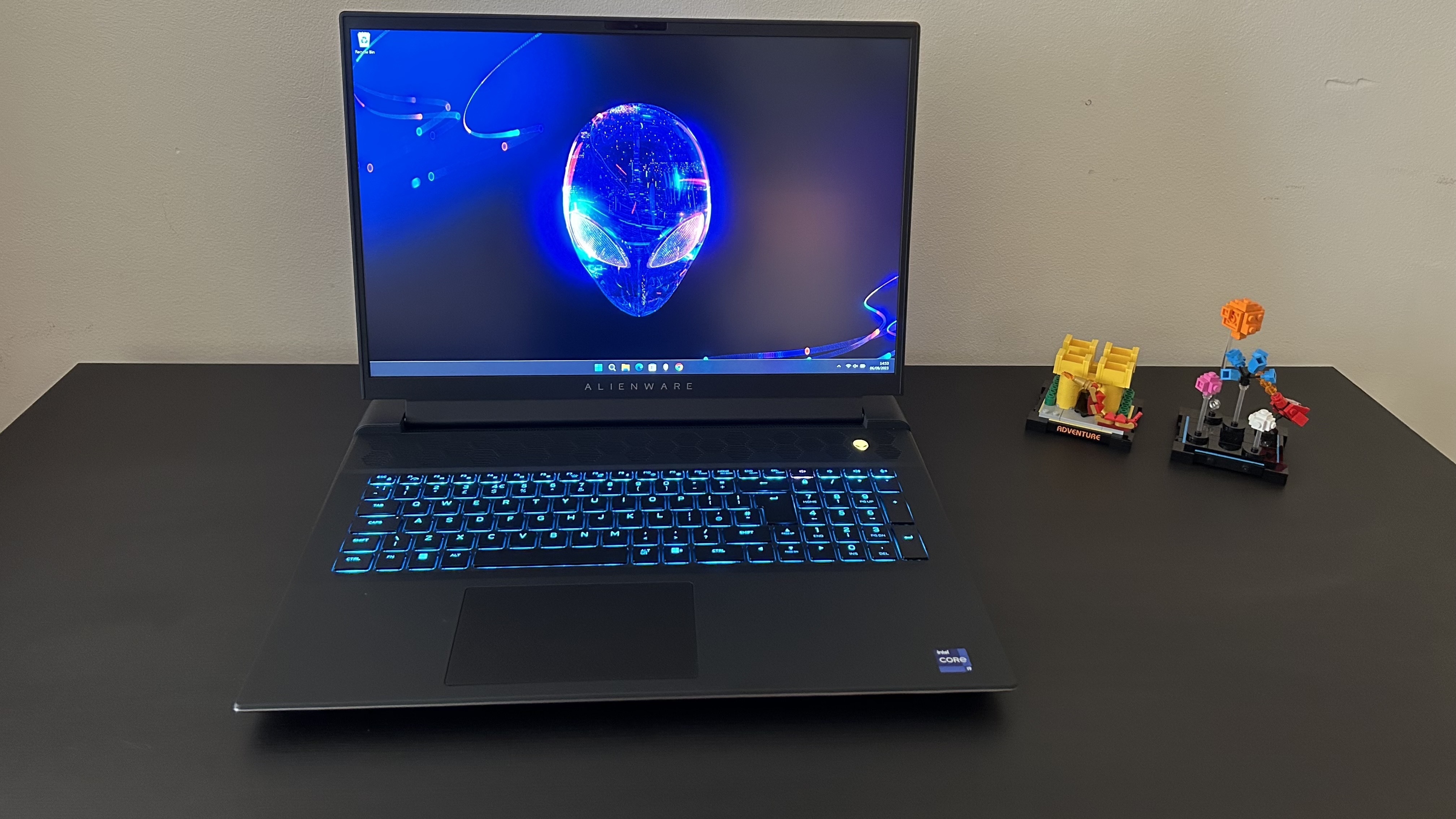
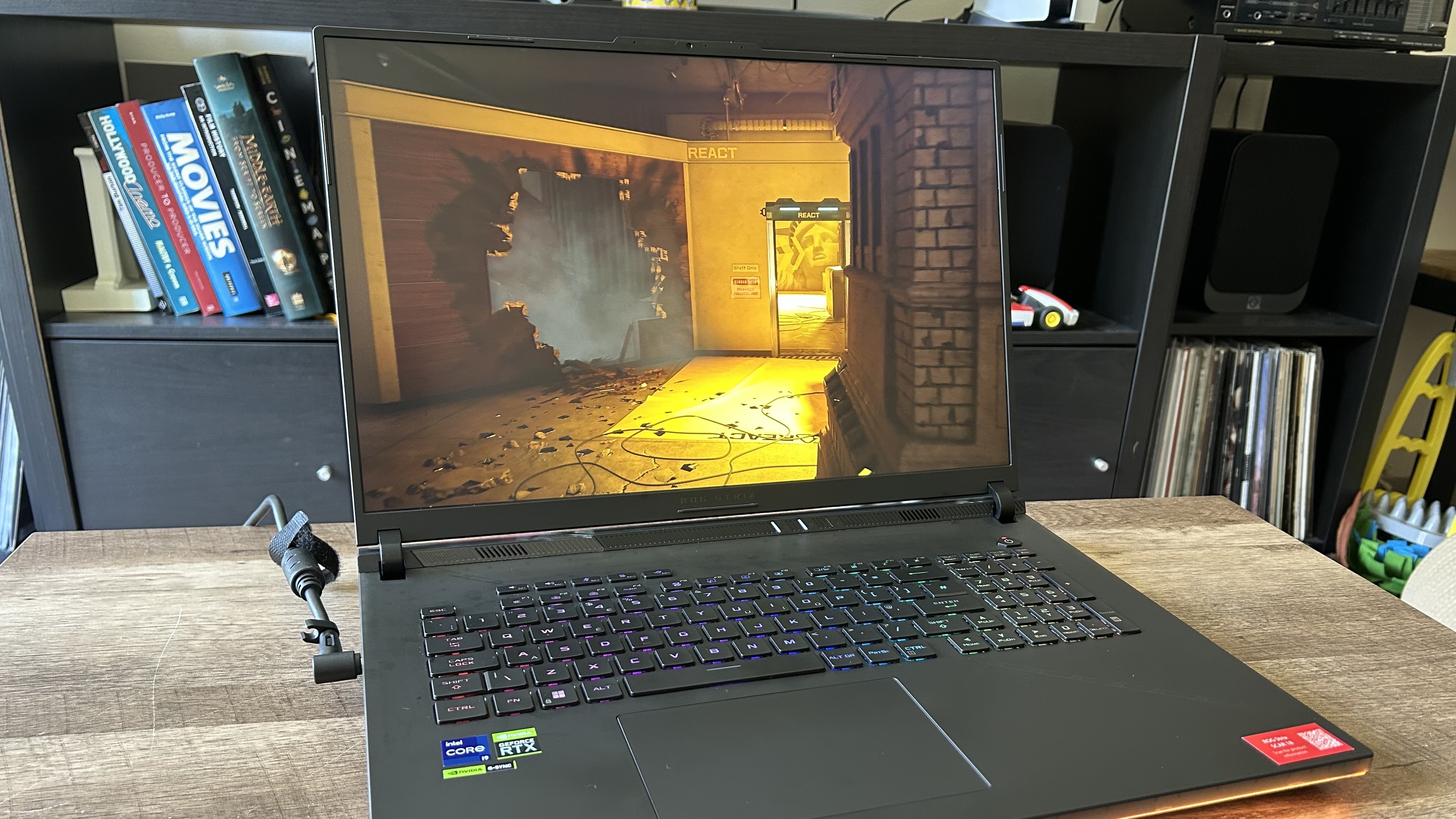
Alienware M18
- Starts at $1,699.99
- More configuration choice
- Similar spec costs less
- AMD options available
Asus ROG Strix Scar 18
- Starts at $2,499.99
- Only high-end configurations
- Similar spec costs more
- No AMD options available
Straight off the bat, it should be mentioned early that if you're working with a max $2,000 budget you'll be looking solely at the Alienware M18. You're not going to find any configurations (at MSRP) of the Asus ROG Strix Scar 18 that will net you that big-screen experience at this price point. Asus's cheapest configuration sits at $2,499.99, thanks to the fact that the Scar 18 only ships with a top end Intel i9-13980HX processor and can't be configured past an RTX 4070 (and I've only seen a handful of those rigs in the UK, US models seem to bottom out at 4080s). You've got far more choice at the lower end of the price spectrum with Alienware, then, but also at the top.
A bank-busting configuration can send you home with a whopping 8TB SSD if you opt for Alienware, coming in at $4,549.99. By comparison, the $3,899.99 Asus maxes out at 2TB of storage. If you're going all out, you've got more room to spend on your M18 rig.
| Header Cell - Column 0 | Alienware M18 | Header Cell - Column 2 | Asus ROG Strix Scar 18 | Header Cell - Column 4 |
|---|---|---|---|---|
| Top Spec | Intel i9-13980HX | Nvidia RTX 4090 | 64GB RAM | 8TB SSD | $4,549.99 | Intel i9-13980HX | Nvidia RTX 4090 | 32GB RAM | 2TB SSD | $3,899.99 |
| Base Spec | AMD Ryzen 9 7845HX | AMD Radeon RX 7600M XT | 16GB RAM | 1TB SSD | $1,699.99 | Intel i9-13980HX | RTX 4070 | 16GB RAM | 1TB SSD | $2,499.99 |
Like for like pricing also puts the Alienware M18 at a lower price point overall. The two laptops I reviewed were pretty evenly matched in their specs; the Alienware offering an Intel i9-13900HX processor with RTX 4090 GPU, 32GB RAM, 1TB SSD, and QHD+ 165Hz display and Asus packing in an Intel i9-13980HX, RTX 4090, 32GB RAM, 2TB SSD, QHD+ 240Hz display. Bumping the Alienware spec up to a 13980HX (the 13900HX doesn't seem to be configurable with an RTX 4090 anymore) brings the price to $3,199.99 - $700 less than the same core components in the $3,899.99 Asus. Yes, you're doubling up your storage and grabbing a faster display, but that's still a considerable price difference.
Winner: Alienware M18
Sign up to the GamesRadar+ Newsletter
Weekly digests, tales from the communities you love, and more
Design
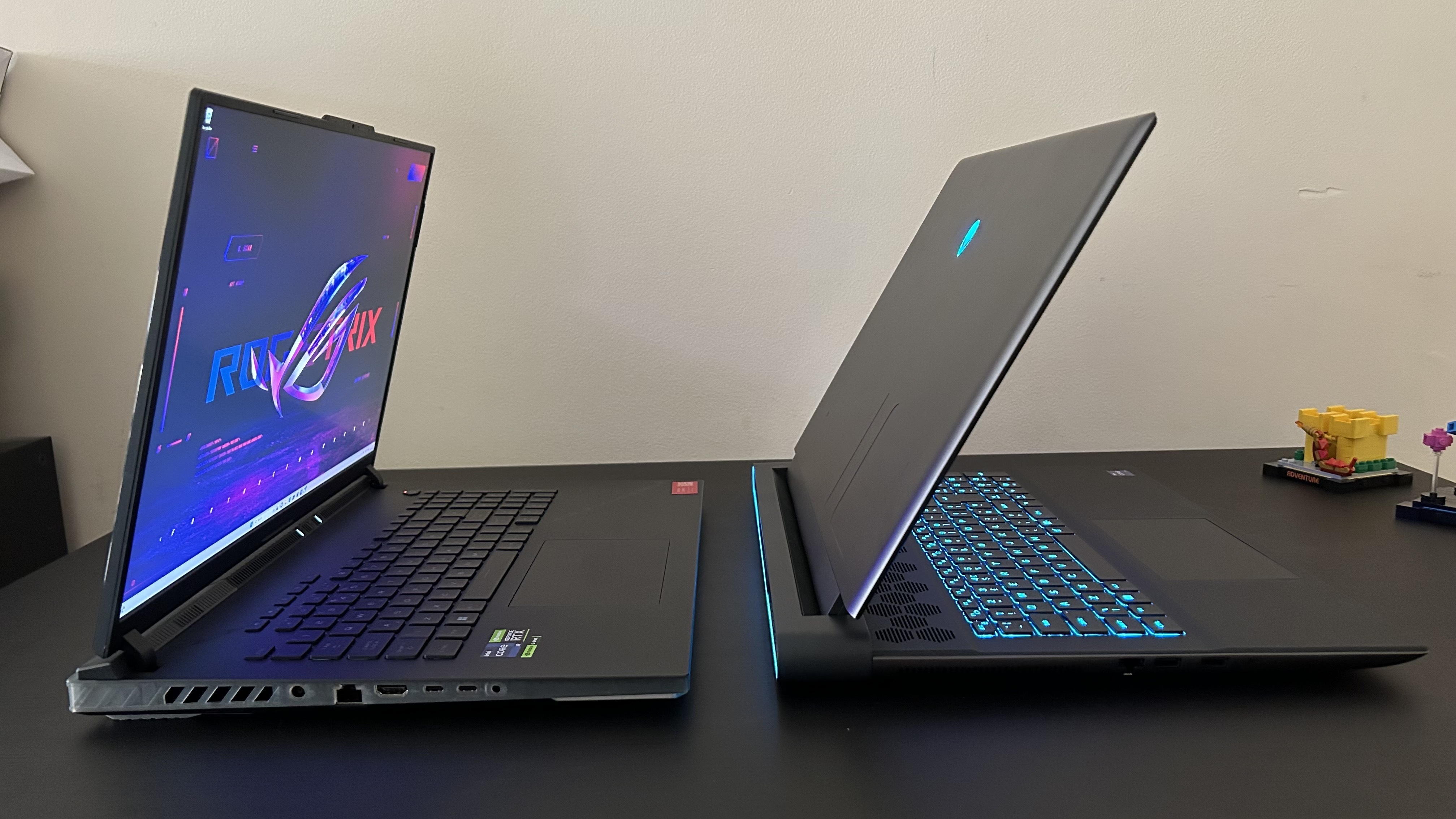
Alienware M18
- Thin, tapered front lip
- Light gray aesthetic throughout
- Subtle use of RGB
- Less sleek external design
- Picks up fingerprints easily
Asus ROG Strix Scar 18
- Boxy, RGB-filled front lip
- Translucent aesthetic
- Heavy use of RGB
- Sleek matte black external design
- Fingerprints don't stick as much
Both the Alienware M18 and Asus ROG Strix Scar 18 are chunky laptops - there's no hiding that 18-inch form factor after all. However, the Alienware has a more refined design which, along with the thinner tapered lip at the front, makes it feel less imposing on the desk top. The effect was so impressive, I was shocked when trying to lift the rig with one hand, it's an aesthetic choice that makes the M18 feel far less chunky than it really is.
By contrast, the ROG Strix Scar 18 has a boxier silhouette with sharper corners and blaring RGB lights running along the front that add to that gaudy aesthetic. The translucent plastic side panels certainly don't help, but this design will be down to personal taste. I personally found the see-through design to cheapen the feel of the device overall, especially as it creeps up through the main base plate towards the hinge.
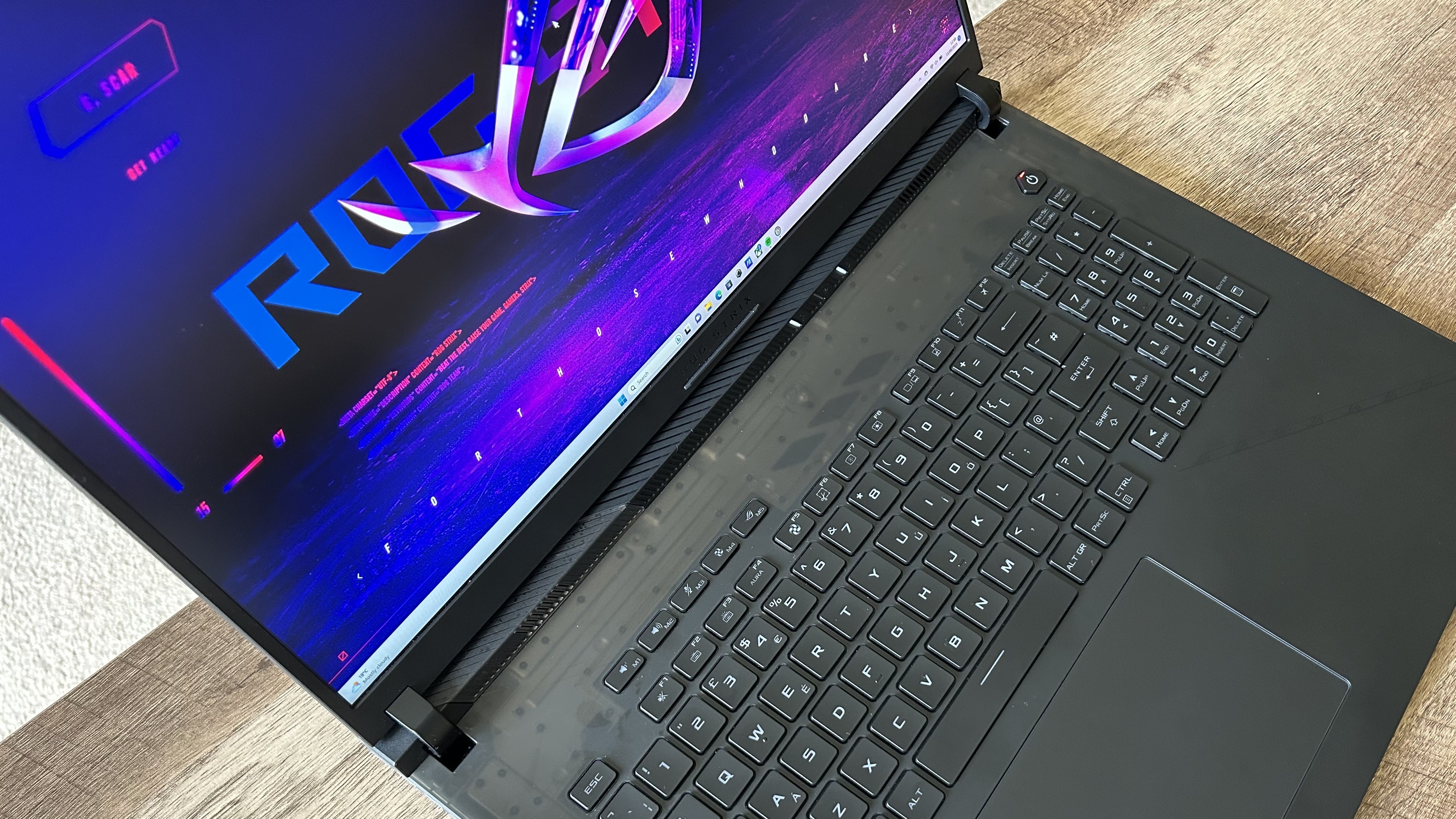
Both laptops are constructed of plastic in the main chassis area, with aluminium lids up top. Both these lid designs are fairly laid back, but with RGB switched on the Alienware is far more subtle. This is a sticking point for me, I personally prefer the aesthetic of the Scar 18 without LEDs, but the M18 with them. Both models offer lighting on their respective logos, but the Asus's ROG icon is far larger and features a blizzard of colors straight out of the box. Alienware keeps things to a cool and controlled blue on a smaller, neater alien head in the center, however the two-tone design of the gray plate itself and the black hinge might be a sticking point.
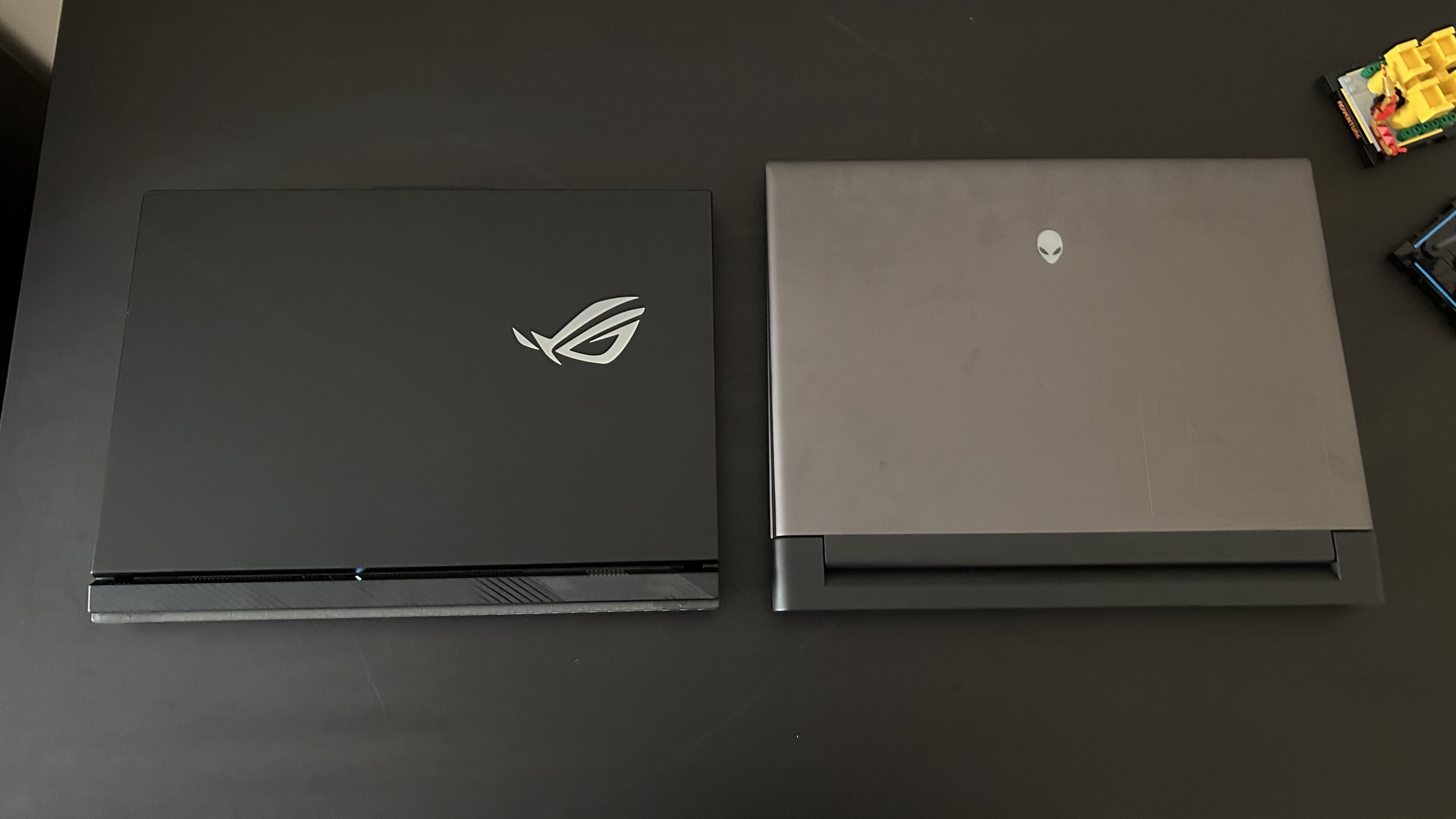
It simply doesn't feel as sleek as the matte black Asus does when those lights are turned off. Throw in the fact that the Alienware picked up significantly more fingerprints in my testing and the Scar 18 is picking up some points.
It's a tough one to call, but the Alienware M18 has just tipped the scales here. The translucent plastic, garish RGB, and boxier outline of the Asus ROG Strix Scar 18 are going to put more players off than win them over.
Winner: Alienware M18
Portability
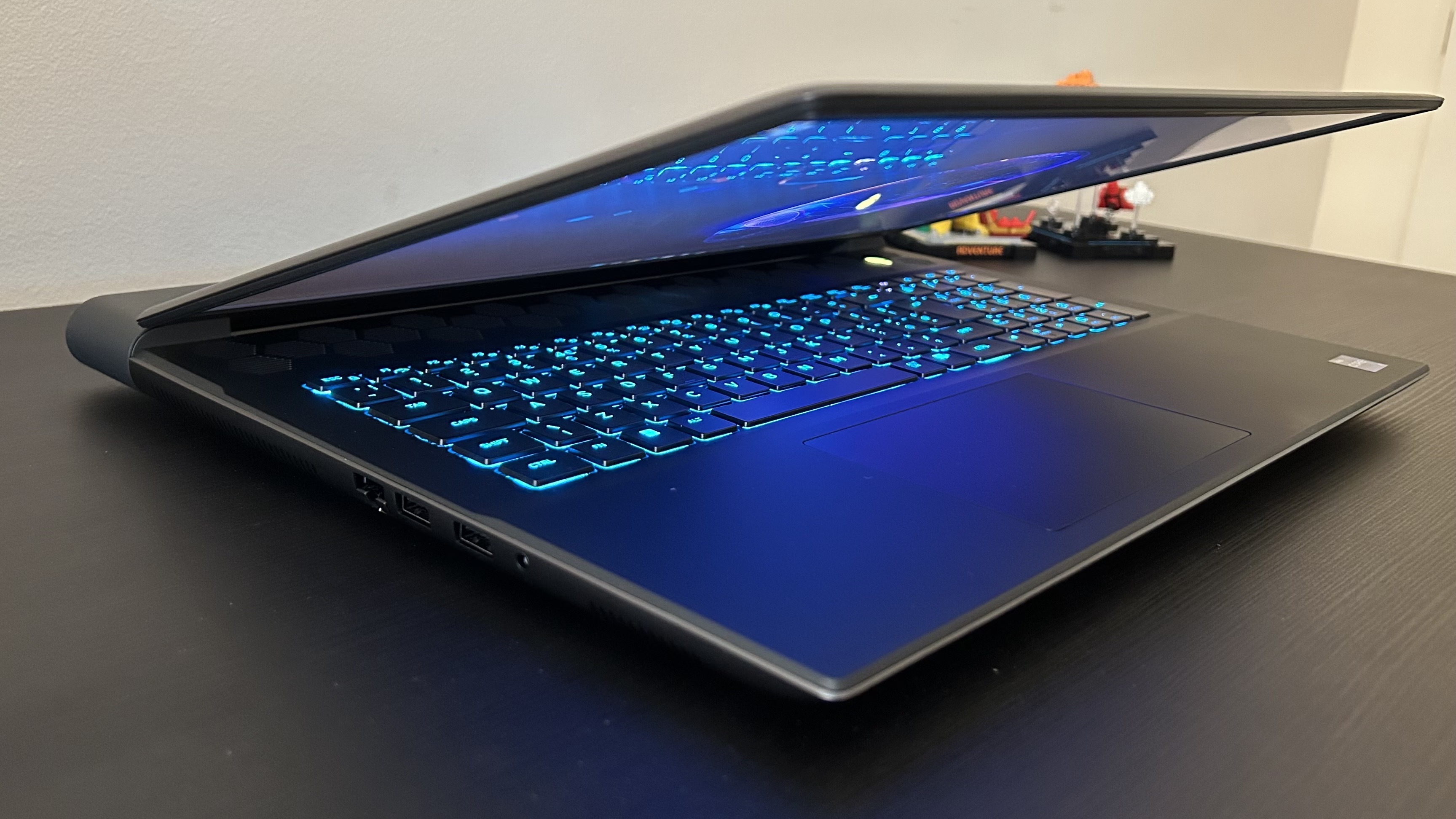
Alienware M18
- 9.32lbs / 4.23kg
- 410 x 319 x 25 mm
- Deeper footprint
- Smaller power pack
Asus ROG Strix Scar 18
- 6.8lbs / 3.1kg
- 399 x 294 x 30mm
- Standard depth
- Larger power pack
This is where Alienware falls down - and that's going to be a heavy fall. The sheer weight of the M18 means it's never going to win awards for portability. Of course, neither machine is easy to transport, they've been designed to do just the opposite - sit on a desk and stay there. However, those who still need the option to take their rig on the road will be sticking to Asus.
Not only does the M18 weigh in at a record 4.23kg (9.32lbs) - over a kilogram more than the 3.1kg (6.8lbs) Scar 18, but its shape also holds it back from being thrown in a laptop. Like many Alienware laptops, the M18 sports a large recess at the back for the hinge. That's a frustration in smaller configurations - here it blocks the laptop from being transported in pretty much any laptop backpack.
Winner: Asus ROG Strix Scar 18
Display
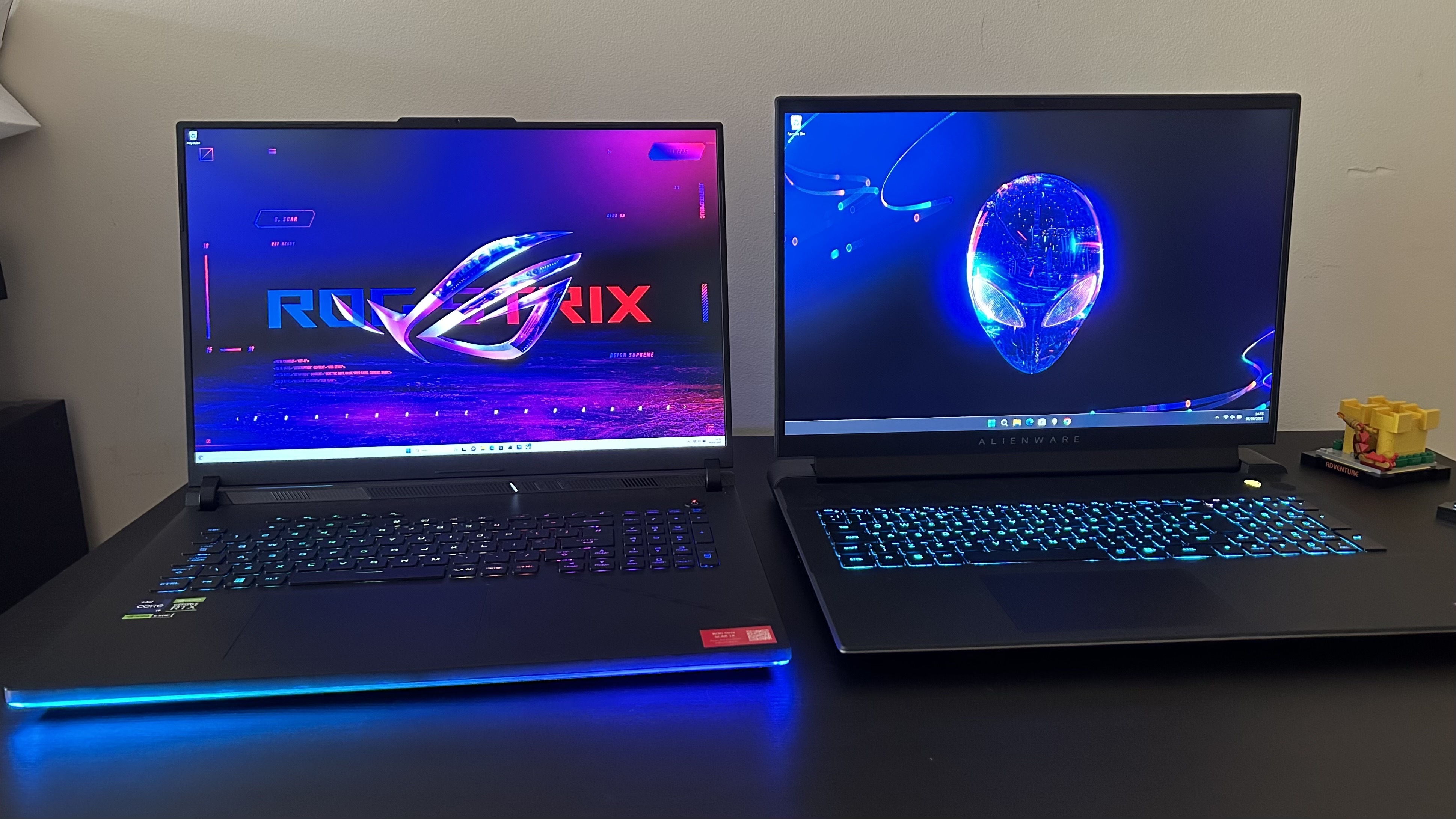
Alienware M18
- 18-inch display
- QHD+ at 165Hz
- FHD+ at 480Hz option
- Low brightness
- Dulled colors
- No HDR
Asus ROG Strix Scar 18
- 18-inch display
- QHD+ at 240Hz
- No FHD+ option
- High brightness
- Super vivid colors
- HDR
Asus also has the upper hand when it comes to the display. While both laptops show off an incredibly immersive 18-inch panel, the QHD+ speed and overall vividity of the Asus ROG Strix Scar 18 makes it far better than the Alienware M18. You're getting a 240Hz 2560 x 1600 display here, compared to the maximum 165Hz refresh rate on the QHD+ Alienware. Considering the majority of current generation 18-inchers are using this 240Hz staple, that's a little disappointing.
Of course, there's a caveat here. If you're a competitive player, you might want to rethink your choice. The Alienware M18 also comes in an FHD+ flavor with a massive 480Hz refresh rate. That's incredible speed for those who want every frame to count, something no configuration of the Asus ROG Strix Scar 18 can keep up with.
Still, the majority of players are going to want a QHD resolution and will feel the pinch of that 165Hz refresh rate. I noted reduced motion handling quality in my own testing, which - considering the price of our review unit - was an unexpected sacrifice.
Not only that, but colors and details were far more vivid on Asus's panel when put side by side. Alienware has a matte coating that dulls the picture slightly, which means colors can blanche in brighter environments and darker details aren't as easily discernible. While the screen included on the ROG Strix Scar 18 isn't the Mini LED I celebrated in the Asus ROG Strix Scar 16, you're still getting HDR and a more immersive experience overall. Side by side, the Alienware struggled to shine bright enough and the Asus was blinding.
Winner: Asus ROG Strix Scar 18
Keyboard
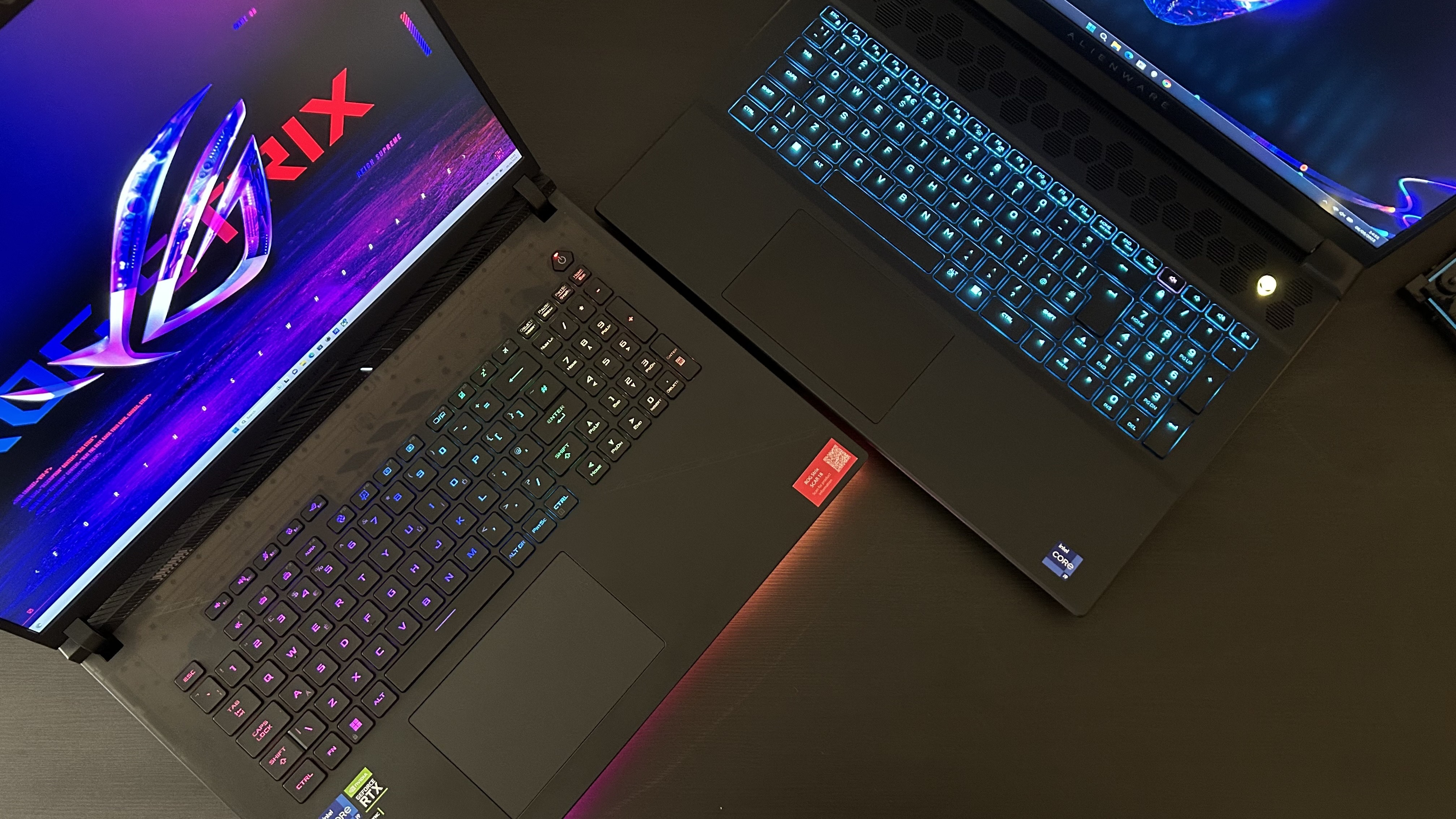
Alienware M18
- Full-sized keys
- Smoother switches
- Closer spacing
- Full-sized number pad
- Less reachable media keys
Asus ROG Strix Scar 18
- Smaller keys
- More tactile switches
- Wider spacing
- Mini number pad
- Easy to reach media keys
Despite looking similar at first glance, the Alienware M18 and Asus ROG Strix Scar 18 sport very different keyboards. Personally, I preferred Alienware's overall, with its slightly larger keys and smoother switches. Of course typing feel is subjective, so if you do prefer a switch with more tension behind it the Scar is going to come out on top. I found that the Scar's keyboard offered more of a mechanical feel because of that extra snap under the fingertip, while the Alienware offers a more silky smooth set of keys to glide across. That's ironic, the M18 is the only model of the two that can be configured to include a Cherry MX set of clickers underneath.
The closer spacing also helps the M18's keyboard feel more cohesive - all the keys are sized in accordance with a standard gaming keyboard, whereas the Scar 18 drops the enter key to half the size and squeezes a miniature number pad on the right. Over on the M18 a full sized enter key feels far more controlled under the hand, and you're getting a full number pad to boot.
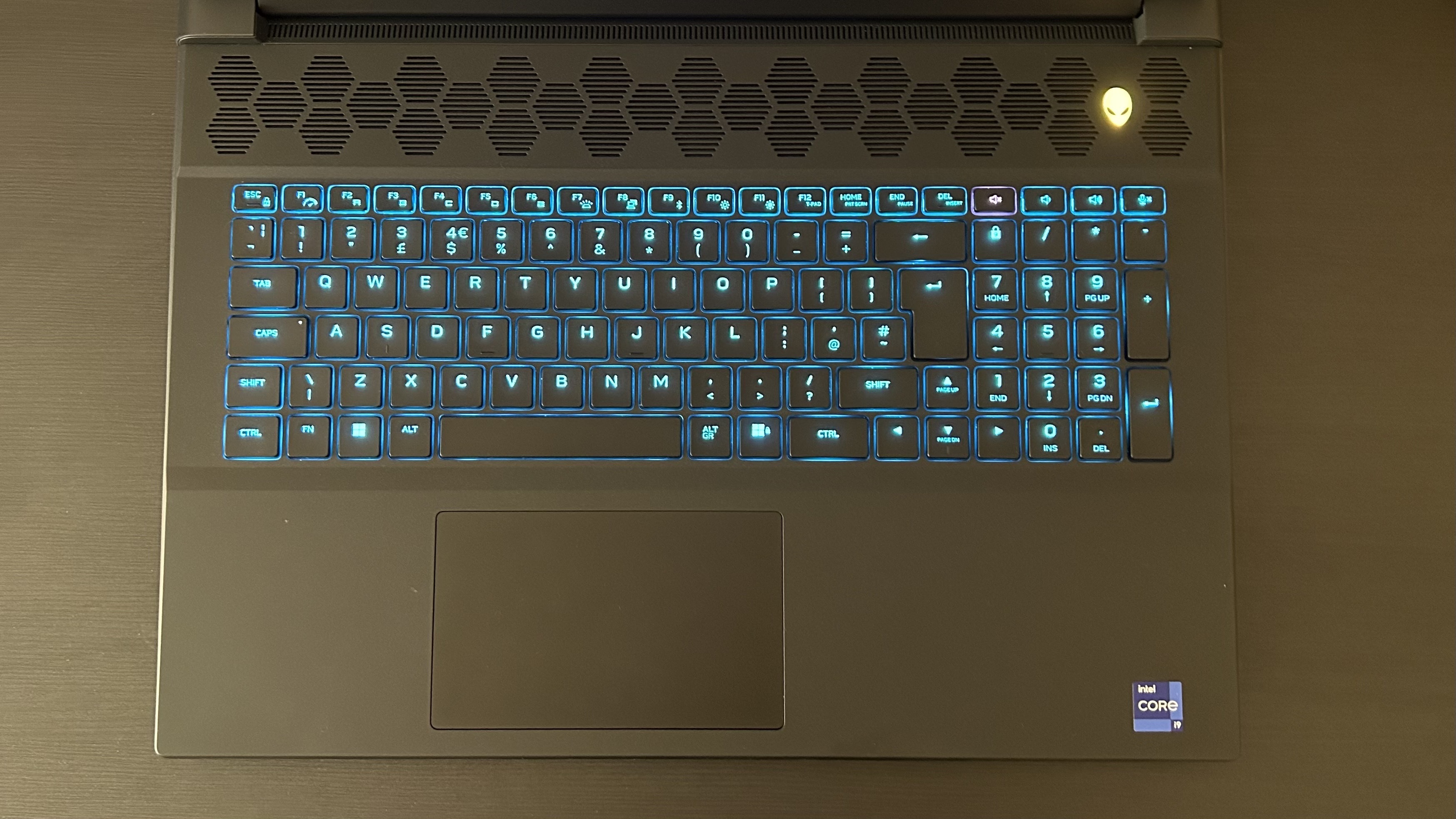
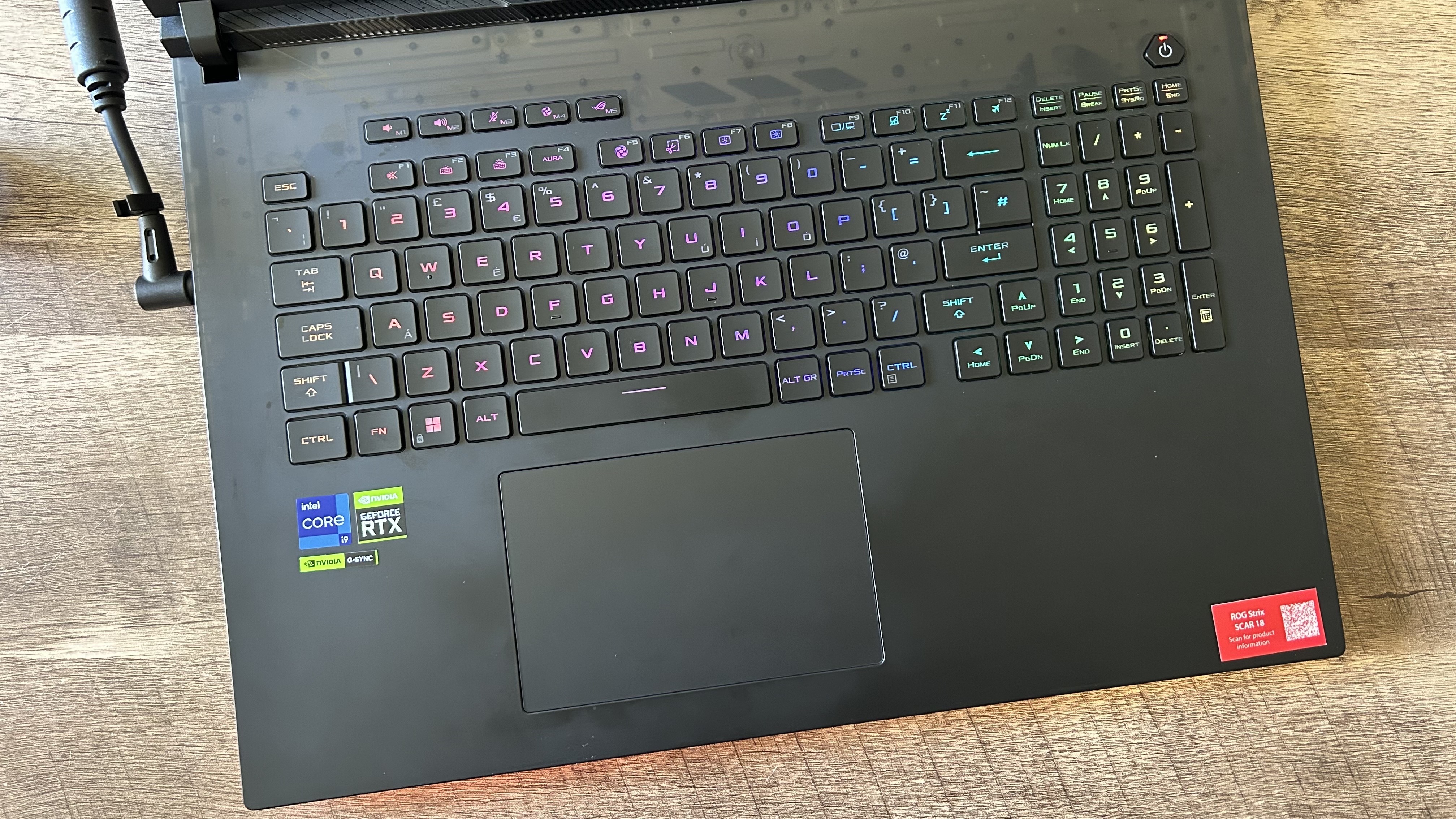
The Asus also inexplicably shifts everything on the function row over to the right, grouping buttons by secondary uses. That took a little getting used to in testing, and may become a frustration if you've already got muscle memory conditioned. While we're being this nitpicky, though, I did prefer the media control placement on the Scar 18. Playback and volume have their own section of the main base board here, whereas they're tacked onto the end of the function row on the M18. Asus's design is a lot easier to hit at a moment's notice, and I did find myself peering across the Alienware deck to try and locate the mute on more than a few occasions.
Winner: Alienware M18
Performance

Alienware M18 Wins
- Returnal
- Total War: Three Kingdoms
- Time Spy
Asus ROG Strix Scar 18 Wins
- Shadow of the Tomb Raider
- Rainbow Six Extraction
- Hitman 3
- Fire Strike
- PC Mark 10
Now we get to the good stuff, and the best news is that the Alienware M18 and Asus ROG Strix Scar 18 are relatively evenly matched in the power department. The two configurations I tested were incredibly similar, with RTX 4090 GPUs at the helm, 32GB RAM and the Scar 18 pushing only slightly ahead with an i9-13980HX CPU vs the Alienware's i9-13900HX. That meant they were poised to go toe-to-toe, and each device had its own set of wins by the time benchmarking was done.
| Specs | Alienware M18 | Asus ROG Strix Scar 18 |
|---|---|---|
| CPU | Intel i9-13900HX | Intel Core i9-13980HX |
| GPU | RTX 4090 | RTX 4090 |
| RAM | 32GB DDR5 | 32GB DDR5 |
| Storage | 1TB PCle 4.0 NVMe M.2 | 1TB + 1TB PCle 4.0 NVMe M.2 |
In-game tests across Shadow of the Tomb Raider, Rainbow Six Extraction, and Hitman 3 worked particularly hard in the Scar 18's favor. These slightly less demanding titles were a breeze for the RGB machine, maxing out at 216fps in Rainbow Six on High settings and 187fps in Shadow of the Tomb Raider on Ultra. The M18 couldn't keep up with these moments, scoring a still respectable 168fps in Rainbow Six at High and 173fps across Lara Croft's Ultra adventures.
However, the M18 didn't give up so easily. It edged just slightly ahead of the Scar 18 in Total War: Three Kingdoms and considerably ahead in Returnal. These heavier games normally give gaming laptops a tougher time, so when given the space to let loose it seems like the M18 is better equipped. Still, it lagged behind in 3/5 tests, handing the majority win over to Asus in-game.
| Game | Alienware M18 | Asus ROG Strix Scar 18 |
|---|---|---|
| Shadow of the Tomb Raider | High: 184fps | Highest: 173fps | High: 191fps | Highest: 187fps |
| Total War: Three Kingdoms | High: 144fps | Ultra: 105fps | High: 140fps | Ultra: 100fps |
| Rainbow Six Extraction | High: 168fps | Ultra: 148fps | High: 216fps | Ultra: 177fps |
| Returnal | High: 152fps | Epic: 138fps | High: 129fps | Ultra: 108fps |
| Hitman 3 | High: 139fps | Epic: 121fps | High: 172fps | Ultra: 143fps |
The same is true for 3D Mark's Time Spy and Fire Strike industry tests, as well as PC Mark 10's CPU benchmark. The Scar 18 managed to nudge a lead in Fire Strike, while dropping slightly behind in Time Spy, but ultimately securing the win across PC Mark 10. It's neck and neck here, but the Scar 18 is still, overall, the more powerful model - though granted, it's certainly not by much.
| Benchmark | Alienware M18 | Asus ROG Strix Scar 18 |
|---|---|---|
| 3D Mark Time Spy | 21,029 | 20,132 |
| 3D Mark Fire Strike | 34,040 | 34,507 |
| PC Mark 10 | 7,704 | 8,948 |
This is a tricky one to call, but going off pure numbers alone, the Asus ROG Strix Scar 18 is the more powerful machine. That could easily be a draw should you choose to switch out your CPU for a more competitive Intel Core i9-13980HX model, though the real-world difference is likely to be negligible for the every day player.
Winner: Asus ROG Strix Scar 18
Extra features
Alienware M18 Wins
- 1080p webcam
- Less powerful speakers
- Rear oriented ports
- More connection options
- Worse software
Asus ROG Strix Scar 18 Wins
- 720p webcam
- Far superior speakers
- Ports placed on the side
- Fewer connection options
- Better software
Of course, there's always extra features to clean up. The Alienware M18 and Asus ROG Strix Scar 18 both have their own secret weapons that could make or break a buying decision. Need a webcam for work meetings? The M18's 1080p lens is far better value than the frustratingly low quality 720p model on the Scar. Don't want to bother with a gaming headset? The speakers on the Strix blow Alienware out the water.
The rear ports of the M18 make far more sense for a desktop-based device, keeping all your cables neatly tucked away out of sight with a handful of options on each side to keep things close. You're also getting far more ports on Alienware's side, with loads of USB-C (with all their various power delivery and Thunderbolt 4 functions) to keep everything connected. By contrast, Asus packs everything around the sides, making for a spider-like mess of cables on top of the desk - not ideal for a permanent setup.
However, Asus's software is far easier to navigate and keeps everything within a moment's notice as well. Dell's Alienware hub has had a makeover with this new release, but it's still clunky and lacking behind others in its competition.
This is, of course, a case of picking and choosing what you need. Each machine brings its own extra special benefits to the table, so the winner is whichever suite of features works better for your use. In general, though, those looking to keep their laptop firmly on the table (and replace a desktop for work as well), will find the Alienware M18's spec sheet more interesting. However, those after a more immersive gaming experience first and foremost will be better set with the Asus ROG Strix Scar 18.
Winner: Tie
Verdict
Both the Alienware M18 and Asus ROG Strix Scar 18 are impressive gaming laptops, but they will serve different playstyles in different ways. If you're looking for an all-in-one desktop replacement then the M18 is better suited. You're sacrificing some screen specs, but you may well be hooking it up to an external gaming monitor anyway. You're making up for it with a lower price point, better port placement, and a 1080p webcam for work.
Meanwhile, those looking for a better quality of experience overall (while sacrificing a few extra features and a subtle design) will prefer the boosted screen and portability of the Asus ROG Strix Scar 18.
We're also exploring the world of the best gaming PCs if you're after something more robust. Or, take a look at the best Razer laptops and the best laptop backpacks for more inspiration.

Managing Editor of Hardware at GamesRadar+, I originally landed in hardware at our sister site TechRadar before moving over to GamesRadar. In between, I've written for Tom’s Guide, Wireframe, The Indie Game Website and That Video Game Blog, covering everything from the PS5 launch to the Apple Pencil. Now, i'm focused on Nintendo Switch, gaming laptops (and the keyboards, headsets and mice that come with them), PS5, and trying to find the perfect projector.


